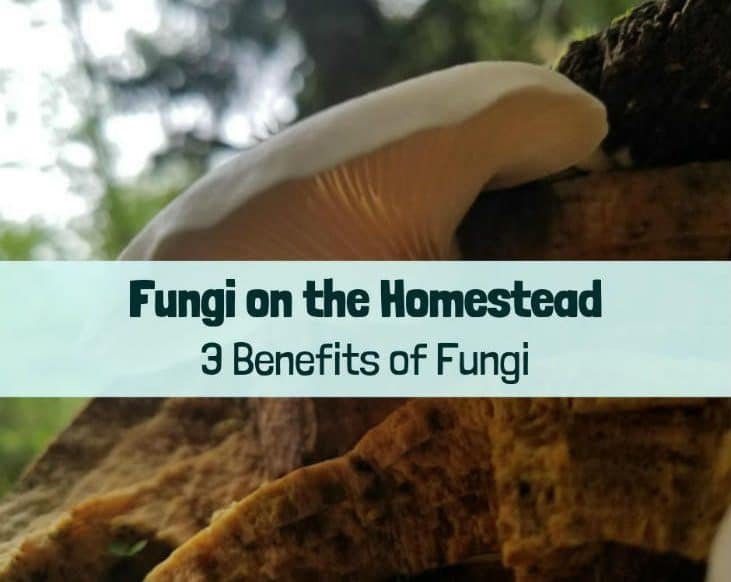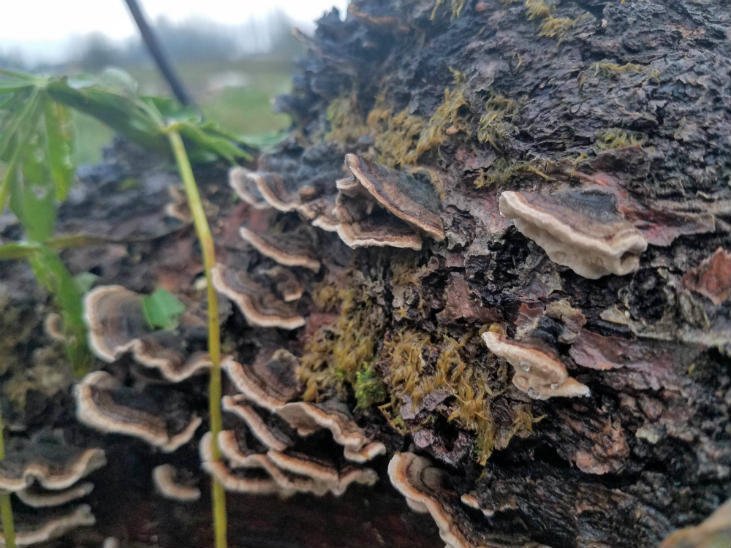Why Fungi are a Great Addition to Your Homestead

Are you supporting fungi on your homestead? Fungi are incredibly useful helpers on any wild homestead. This week’s blog post—Fungi on the Homestead - 3 Benefits of Fungi—summarizes all the amazing benefits of fungi into 3 core categories.
These categories are:
- Building Soil
- Helping Your Plants Grow
- Providing an Edible Harvest
You could write a book for each of these 3 categories but the blog post covers both enough to help you start to understand why fungi are so beneficial to your homestead.
When I see the fruiting bodies of fungi (mushrooms) popping up in an area I have just started transforming I know I’m doing something right.
What I Find to be the Most Amazing Part of Fungi
Fungi are just simply amazing with their ability to help build soil and unlock nutrients for your plants and provide great harvests for you and your homestead. But what I really find amazing with fungi is their ability to create an interconnected web with most of the plants in an ecosystem.
This interconnected web is often referred to as the wood wide web.
Nature is all about creating connections between diverse members of an ecosystem, but this fungi/plant network is just amazing.
The wood wide web is not just about the fungi sharing nutrients and water with plants in exchange for sugars. It goes far beyond this simple exchange network.
Through the wood wide web plants can share nutrients with each other and not just with fungi. In addition, the plants can even send warnings about pests to each other.
But one of the most amazing aspects of the wood wide web is that it has been shown that when a tree is dying it will sometimes dump its nutrients in a final sacrifice to help support the next generation of seedlings growing around it that are all connected through the wood wide web.
For me the biggest lesson to take after you learn about the wood wide web is that fungi are key to a healthy, resilient and abundant wild homestead. Because of this I whenever I’m getting ready to plant in a new area I always make sure to support a rich fungal community.
This means lots of wood chips and other organic material. I’m always chop-and-dropping and adding mulch to my planting areas.
I want to create the habitat that will support the most fungi. This also means that I love building hugelkultur beds and I’m often adding snags and other woody debris to the surface of my planting areas.
The result has been a ton of fungi growing on my wild homestead.
What Do You Do to Support Fungi on Your Homestead?

There is a lot you can do to support fungi on your homestead. What do you do?
I like to add mulch, woody debris and of course a diverse plant community to support the widest range of fungi possible.
I would love to hear what you do.
Please leave a comment saying how you support fungi on your homestead.
And before you head out make sure to check out the blog post for more information about the 3 core types of benefits provided by fungi.
Thank you!

Follow me for more posts all about homesteading, working with nature, and growing your own food: @wildhomesteading
And check out my blog - www.wildhomesteading.com for weekly in-depth posts on working with nature to grow your own food and start/build your homestead.
Love to see 'shrooms growing. Do you know of any that do well in a desert environment? I line in So. Nevada and most of the time it is to dry to even spit. I have started a Hugul mound using debris from dead trees, but even that is kind of slow going.
Liked your article, keep up the GREAT work..
I'm afraid I don't have any experience with fungi in desert areas. In general I would use thick mulch and for hugelkultur beds I would dig down and make at least half of the bed be below regular ground level by about 2 feet or so (or even deeper - I dug some beds that are 3 feet deep plus 1 foot above ground). If you are trying to grow mushrooms for eating then shady sheltered areas are going to work best. I would also try to retain as much water when it rains as possible using earthworks, mulch and plants for shade. Hope that helps!
Posted using Partiko Android
Sorry about the delay,,, @wildhomesteading, I don't think many people do have much experience with desert fungi.
For my hueggle mound I went down about a foot, then had to buy a new Matock. Much of the soil here is a clay that used to be called "Zeolite" and along with Vermiculite was used in potted plants. Anyway, sorry, I digress. One of my biggest concerns is, of course, water retention. I dig down anywhere from 5ft. down and line the bottom and lower sides with rock then fill back in the hole, creating artificial cisterns. We also live on Well Water so this helps there too. We've been here for about 2.5 years now and have gotten a wopping 3" of rain. Southern Nevada just across the hill from Death Valley.
Mostly trying to re-purpose the land here for Organic use but very much straw cultivation is prohibitive for the cleaning.
In about 2 more months I will get back to the mound I am trying to get setup. Hopefully the temp will be below 100f and I will get more than an hour a day to work.
Again, many thanks for the response and ideas for my mounding... Mitch, out
Awesome article sir. Thanks for sharing so much value here
Thank you! :) good to hear that you are enjoying the articles. I appreciate the comment!
Posted using Partiko Android
You have been curated by @mosunomotunde on behalf of Inner Blocks: a community encouraging first hand content, with each individual living their best life, and being responsible for their own well being. Check it out at @innerblocks for the latest information and community updates, or to show your support via delegation.
Thank you!
Posted using Partiko Android
Your post made me chuckle, here in monsoonal Thailand with a humidity of 97% and temps in the 90s - you only have to stand in the kitchen for 5 mins and some kind of mushroom or mold grows on your feet. LOL. What are we having for dinner? sauteed mushrooms and garlic with black rice, dahl and fresh raw vegetables. NICE post. Let me assure you the world is unlikely to ever run our of mold or fungi spores, not from the way I see it today anyway. LOL
Leading the curation trail for both @ecotrain & @eco-alex.
Together We’re Making This World A Better Place.
Click Here To Join the manually curated trail "@artemislives" to support quality eco-green content.
@ecoTrain
Lol, yeah your climate is very different then the temperate one here. But often I see people here trying to kill fungi in the garden with chemicals or using methods that negatively impact fungi. The destruction of fungi in the soil is a fairly big problem in this area. I have had people ask me if mushrooms were okay to have in their gardens. I want to help those people understand the benefits that fungi bring so they won't just kill them and perhaps they will even do things to promote the beneficial ones.
Posted using Partiko Android
It's hard for me to imagine people trying to kill fungi... they are amazing beings. But yes, we have them to over-abundance-saturation point right now. It was a GOOD post and an important one for people in drier, cooler climates. And yes, fungi are a big part of the magic that makes soil thrive!
You got a 6.08% upvote from @ocdb courtesy of @wildhomesteading! :)
@ocdb is a non-profit bidbot for whitelisted Steemians, current max bid is 15 SBD and the equivalent amount in STEEM.
Check our website https://thegoodwhales.io/ for the whitelist, queue and delegation info. Join our Discord channel for more information.
If you like what @ocd does, consider voting for ocd-witness through SteemConnect or on the Steemit Witnesses page. :)
You've been visited by @minismallholding from Homesteaders Co-op.
Some great information as always. Thank you for sharing. I have featured this post in the [Homesteaders – Living Naturally newsletter](https://steemit.com/homesteading/@homesteaderscoop/homesteaders-living-naturally-newsletter-21st-august-2019
A community marketplace of ethical, handmade and sustainable products available for STEEM, SBD (and USD): https://homesteaderscoop.com
follow: @homesteaderscoop
Thank you so much! Really appreciate it!
Posted using Partiko Android